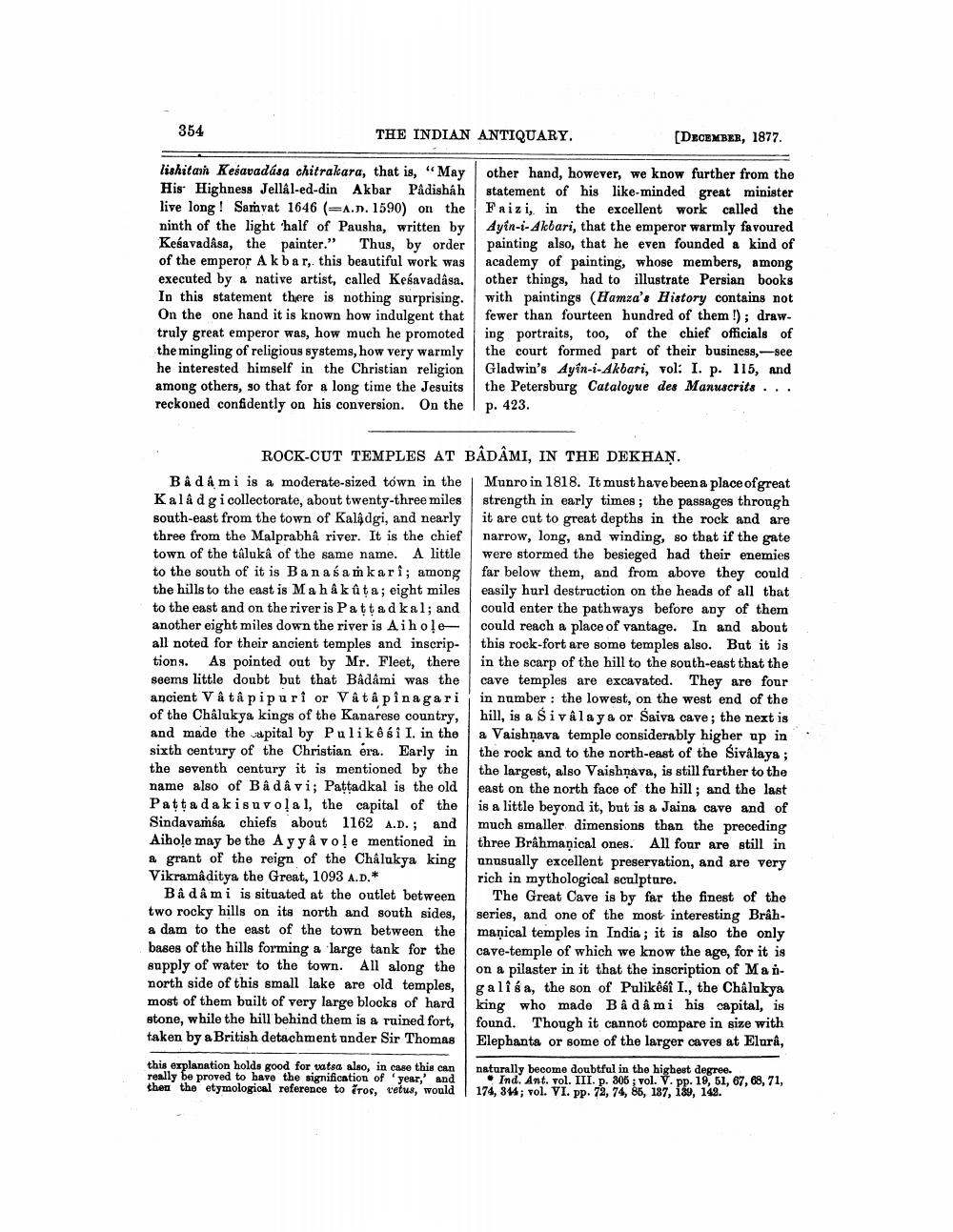________________
354
THE INDIAN ANTIQUARY.
[DECEMBER, 1877.
lishitah Kesavadása chitrakara, that is, "May His Highness Jellal-ed-din Akbar Padishah live long ! Samvat 1646 (=A.D. 1590) on the ninth of the light 'half of Pausha, written by Kesavadasa, the painter." Thus, by order of the emperor Akbar, this beautiful work was executed by a native artist, called Kesavadâsa. In this statement there is nothing surprising. On the one hand it is known how indulgent that truly great emperor was, how much he promoted the mingling of religious systems, how very warmly he interested himself in the Christian religion among others, so that for a long time the Jesuits reckoned confidently on his conversion. On the
other hand, however, we know further from the statement of his like-minded great minister Faizi, in the excellent work called the Ayin-i-Akbari, that the emperor warmly favoured painting also, that he even founded a kind of academy of painting, whose members, among other things, had to illustrate Persian books with paintings (Hamza's History contains not fewer than fourteen hundred of them !); draw. ing portraits, too, of the chief officials of the court formed part of their business, - see Gladwin's Ayin-i-Akbari, vol: I. p. 115, and the Petersburg Catalogue des Manuscrits ... p. 423.
ROCK-CUT TEMPLES AT BÅDÂMI, IN THE DEKHAN. Bad A mi is a moderate-sized town in the Munro in 1818. It must have been a place of great Kalådgi collectorate, about twenty-three miles strength in early times; the passages through south-east from the town of Kaládgi, and nearly it are cut to great depths in the rock and are three from the Malprabhå river. It is the chief narrow, long, and winding, so that if the gate town of the taluka of the same name. A little were stormed the besieged had their enemies to the south of it is Banaśam kari; among far below them, and from above they could the hills to the east is Ma hakata; eight miles easily hurl destruction on the heads of all that to the east and on the river is Pattad kal; and could enter the pathways before any of them another eight miles down the river is A i hole could reach a place of vantage. In and about all noted for their ancient temples and inscrip- this rock-fort are some temples also. But it is tions. As pointed out by Mr. Fleet, there in the scarp of the hill to the south-east that the seems little doubt but that Badami was the cave temples are excavated. They are four ancient V Atå pipuri or Våt å pinagari in number: the lowest, on the west end of the of the Châlukya kings of the Kanarese country, hill, is a Sivalaya or Saiva cave; the next is and made the capital by Pulikô si I. in the a Vaishnava temple considerably higher up in sixth century of the Christian era. Early in the rock and to the north-east of the Sivalaya ; the seventh century it is mentioned by the the largest, also Vaishṇava, is still further to the name also of Bå då vi; Pattadkal is the old east on the north face of the hill; and the last Pattada kisu volal, the capital of the is a little beyond it, but is a Jaina cave and of Sindavamsa chiefs about 1162 A.D.; and much smaller dimensions than the preceding Aihole may be the Ayyâ vole mentioned in three Brahmaņical ones. All four are still in & grant of the reign of the Châlukya king unusually excellent preservation, and are very Vikramaditya the Great, 1093 A.D.*
rich in mythological sculpture. Båda mi is situated at the outlet between The Great Cave is by far the finest of the two rocky hills on its north and south sides, series, and one of the most interesting Braha dam to the east of the town between the maņical temples in India; it is also the only bases of the hills forming a large tank for the cave-temple of which we know the age, for it is supply of water to the town. All along the on a pilaster in it that the inscription of Man north side of this small lake are old temples, galîsa, the son of Pulikest I., the Chalukya most of them built of very large blocks of hard king who made Bad â mi his capital, is stone, while the hill behind them is a ruined fort, found. Though it cannot compare in size with taken by a British detachment under Sir Thomas Elephanta or some of the larger caves at Elura,
this explanation holds good for watsa also, in case this can really be proved to have the signification of year, and then the etymological reference to tros, vetus, would
naturally become doubtful in the highest degree.
Ind. Ant. vol. III. p. 805 ; vol. V. pp. 19, 51, 67, 68, 71, 174, 844; vol. VI. pp. 72, 74, 86, 187, 130, 142.




